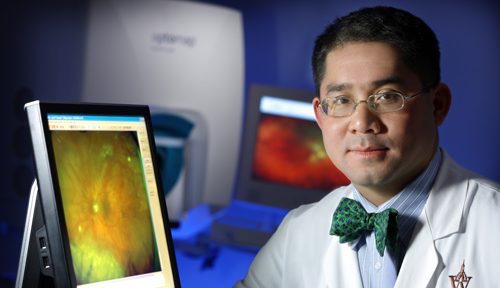Kaleidoscope.
It’s the last piece that will connect ophthalmology with the rest of the One Chart electronic health record enterprise. The “go live” date for ophthalmology is the week of Aug. 26.
“We are thrilled to bring ophthalmology and the Truhlsen Eye Institute online with the rest of the campus enabling our colleagues in other specialties to see up-to-the minute assessments and treatment plans of their patients with eye conditions,” said Quan Dong Nguyen, M.D., director of the Truhlsen Eye Institute.
“Kaleidoscope is the EpicCare specialty product designed to accommodate the functionality that ophthalmology needs,” said Lynn Borstelmann, director, clinical applications.
“Kaleidoscope provides the infrastructure that clinicians need to capture discrete data elements and facilitate practice analysis and outcomes reporting. The intensive use of devices and images in the ophthalmology documentation workflows has provided challenges for the project team of technical, clinical and One Chart experts. The successful result is improved integration and visibility of information in one system.”
Physicians in other areas using One Chart will now be able to see things such as the severity of diabetic eye disease present in their patients with diabetes. Physicians can also keep track of the ocular exam findings in patients with rheumatologic conditions, many of which cause inflammation in the eye, enabling better collaboration and continuum of care on a patient.
“Being able to rely on competently documented medical information versus patient-provided information greatly enhances the quality of care given to each patient,” said Patti Fries, assistant professor of ophthalmology. “Additionally, other physicians across campus now have pertinent ophthalmic feedback as well. With an ever-evolving legal climate, having an electronic system that reminds us of requirements will help ensure that we meet them as they emerge.”
In addition to sharing of information across specialties, the go live also includes a picture archive and communication system (PACS) called Zeiss FORUM. This will allow ophthalmology providers to view images in exam rooms without going directly to the instruments. All images are sent to a central database and can be accessed from any workstation in the three Truhlsen Eye Institute locations.
“With the implementation of the Zeiss PACS, we have the ability to provide anywhere, anytime access to the ophthalmology images,” says Mike Battreall, director of medical information systems. “This functionality, along with the integration to One Chart, takes us another step further to an integrated enterprise.”
